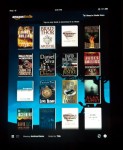We are seeing more and more digital content, including:
- E-Books
- Downloadable & streaming movies and TV shows
- Apps and games
- Magazines
- Newspapers
This digital content costs less to produce and distribute than the non-digital version. It eliminates printing costs, fabrication of DVDs and DVD cases, and shipping costs, just to name a few. So why isn’t this stuff getting less expensive?
The problem is that the content providers are generally overcharging. Why can I rent a DVD from RedBox for $1, or unlimited movies for a month from Netflix for $9, but on the iTunes Store I’d have to pay $5 just to stream a movie one time, or $15 to download it? Why are you charging $3 for a single TV episode I could watch for free? Why are many e-books $9.99 and up, even when they have a paperback version out for several dollars less? Do they really expect me to pay $5 for a single issue of Time magazine, or $20 a month for the Wall Street Journal? Don’t they give it away for free on their website?
And, one thing I quickly noticed on my wife’s new iPad: all those $0.99 and $1.99 and $2.99 iPhone apps have iPad versions that tack “HD” onto the title and sell for $4.99, $9.99, and $14.99. A tad greedy, methinks.
What these content providers don’t seem to realize is that the great benefit of digital content is that there is no marginal cost. Once the content itself is created, you can sell an unlimited number of digital copies for essentially no cost. Yet, many of these providers are still stuck in the tangible retail model, where they need to make a certain profit margin on each book, or CD, or magazine that they print or produce. What they fail to realize is that they could cut prices in half and probably sell 3, 5, maybe even 10 times as much content, doubling or tripling their revenue and profits. (Also, to the extent that magazines and newspapers make a lot of money on advertising, even selling only twice the content at half the cost is a huge win for them.)
I grappled with pricing issues with my e-books. I first priced them at $4.77 each. I figured that was a “fair” price for an e-book, about half the cost of a paperback, so the readers were getting a good deal. But then a funny thing happened. I tried selling them for just 99 cents each. A little voice in my head cried out that I was “devaluing” all my hard work (those books took over a year each to produce) and that they were “worth” more than that. But when I sold 7, then 20, then 35 times more copies at $0.99 than I did at $4.77, it didn’t take long for me to silence that tiny voice. But what I don’t understand is that, if I can figure that out, why can’t the movie studios, large publishers, and newspapers?
Think about it. I’m not gonna pay $5 to digitally rent a movie I can get for $1 elsewhere. But if that movie was $1 or $2, I’d probably digitally rent at least a few a month for the added convenience. So, the movie studio can make $0 off of me, or $6 a month. Remember, it costs them almost nothing to actually stream the video to me. So who’s winning with these high prices?
That doesn’t even consider the fact that higher prices increase piracy. I don’t think overcharging makes piracy okay (you’re still illegally downloading something you didn’t pay for), but it helps people justify it in their own minds when they can say, “Screw these greedy movie studios. I’d never pay $15 for that movie anyway, so they’re not really losing anything by me pirating it.” When an e-book is just 99 cents, for example, the vast majority of people would rather just pay what they consider a fair price than resort to piracy. Apple figured that out with 99 cent music downloads … and the greedy music studios forced them to raise prices to $1.29 … and (prepare to be shocked) digital music sales declined for the first time ever.
On the other end of the spectrum is the “everything should be free on the Internet” model, which people are slowly realizing doesn’t work (even newspapers are finally figuring it out as they lay off reporters and editors). The problem with everything being free is that the people who create quality content need to get paid, so you can get insightful commentary, professional journalists who can travel to report on stories, quality television and movies, and well-written novels. If even the people who are very good at creating content can’t make a living at it, they will take their talents somewhere else that pays the bills, and we’ll all be poorer for it.
So, my belief is that people are willing to pay reasonable prices for digital content (read: less than the old cost of physical content), and that lower prices (that are still above free) will result in more sales and more revenue, and will allow more people to enjoy more content. That’s a win-win in my book.


